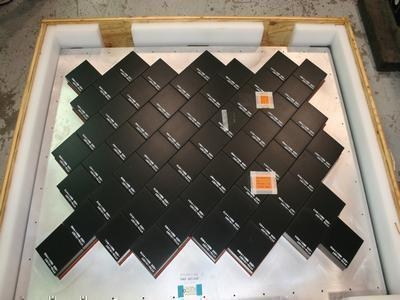Thu, Sep 06, 2012
Museums And Schools Eligible To Receive The Sought-After Artifacts
NASA is expanding its offer to museums and schools of space shuttle heat shield tiles and food packaged for spaceflight. Beginning Tuesday, museums across the United States will be eligible to receive these pieces of space history, in addition to the schools and universities that have received them since the end of the Space Shuttle Program.

Providing space shuttle thermal protection tiles and dehydrated astronaut food to museums is a way for NASA to share technology and history with the public. This initiative helps NASA inspire the next generation of space explorers, scientists and engineers. The lightweight tiles protected the shuttles from extreme temperatures when they re-entered Earth's atmosphere. The astronaut food was precooked or processed so it required no refrigeration and was ready to eat. It could be prepared simply by adding water or by heating.
Requests for these artifacts are filled on a first-come, first-served basis. Museums must obtain a user ID and password from their state agency for surplus property. Eligible educational institutions need their National Center for Education Statistics or Integrated Postsecondary Education Data System numbers assigned by the U.S. Department of Education to apply for this offer.
Tiles are available in three types: black-coated, white-coated and uncoated. Institutions may request up to three tiles, one of each type, while supplies last. Schools and museums are responsible for a $23.40 shipping and handling fee per tile, which is payable to the shipping company through a secure website. Space food is offered as a package of approximately three space food items for a shipping and handling fee of $28.03. Institutions may request only one package of space food.
NASA also is offering artifacts representing significant human spaceflight technologies, processes and accomplishments from its space exploration programs. Artifacts include 11 Fastrac engine nozzles used on X-34 aircraft; models of aircraft fuselages tested at NASA's Langley Research Center in Hampton, VA.; early space shuttle prototype models; Ranger, Telestar, Explorer XII, Mariner VII, Nimbus and other spacecraft models; X3 solar mirrors; and various space shuttle components.
(Image provided by NASA)
More News
From 2021: The Inside Skinny On What Being An ANN Oshkosh Stringer Is All About By ANN Senior Stringer Extraordinare, Gene Yarbrough The annual gathering at Oshkosh is a right of p>[...]
Video Showed That During The Takeoff, The Nose Baggage Door Was Open On May 10, 2025, about 0935 eastern daylight time, a Piper PA-32RT-300, N30689, was destroyed when it was invol>[...]
Get The Latest in Aviation News NOW on Instagram Are you on Instagram yet? It's been around for a few years, quietly picking up traction mostly thanks to everybody's new obsession >[...]
"I think what is key, we have offered a bonus to air traffic controllers who are eligible to retire. We are going to pay them a 20% bonus on their salary to stay longer. Don't reti>[...]
Aero Linx: Pilot Briefing The gathering, translation, interpretation, and summarization of weather and aeronautical information into a form usable by the pilot or flight supervisor>[...]
 Oshkosh Memories: An Aero-News Stringer Perspective
Oshkosh Memories: An Aero-News Stringer Perspective NTSB Prelim: Piper PA32RT
NTSB Prelim: Piper PA32RT ANN FAQ: Follow Us On Instagram!
ANN FAQ: Follow Us On Instagram! Aero-News: Quote of the Day (05.28.25)
Aero-News: Quote of the Day (05.28.25) ANN's Daily Aero-Term (05.28.25): Pilot Briefing
ANN's Daily Aero-Term (05.28.25): Pilot Briefing



